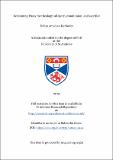Files in this item
Reclaiming Pusey for theology: allegory, communion, and sacrifice
Item metadata
| dc.contributor.author | Karlowicz, Tobias Amadeus | |
| dc.coverage.spatial | 265 | en_US |
| dc.date.accessioned | 2013-10-29T12:30:00Z | |
| dc.date.available | 2013-10-29T12:30:00Z | |
| dc.date.issued | 2013-11-30 | |
| dc.identifier | uk.bl.ethos.581838 | |
| dc.identifier.uri | https://hdl.handle.net/10023/4122 | |
| dc.description.abstract | Edward Bouverie Pusey once towered over nineteenth-century British theology, but he has now fallen into almost entire insignificance. However, analysis of this decline (Chapter 1) leads to a reassessment. His development—especially his complicated relationship with pre-Tractarian High Church Anglicanism—shows a deep criticism of post-Enlightenment intellectual trends, from his early years through his association with the Oxford Movement and the Tracts for the Times, to the end of his life (Chapter 2). This criticism led him to the patristic use of allegory, both as a biblical hermeneutic and as a creative, complex, image-based approach to theology (Chapter 3). His development of High Church theology (seen especially through comparison with Waterland) and his use of allegory can be traced throughout his theology. His understanding of union with Christ and theosis reveals both: the sacraments have a strong symbolic dimension, while his positions on baptismal regeneration and the real presence of Christ in the Eucharist show a development rather than a rejection of earlier High Church theology (Chapters 4 and 5). His understanding of the atonement blends High Church reliance on sacrificial types with his unitive theology to reconfigure traditional satisfaction theory as restoration of love for God, rather than redemption from punishment—a position which marks Pusey as an important transitional figure in 19th c. theology (Chapter 6). The flexibility of Pusey’s allegorical approach also allows him to blend a High Church tradition of spiritual sacrifice with sacramental participation in Christ’s self-offering, so that sacrifice becomes an aspect of union with Christ (Chapter 7). Pusey’s use of allegory shows similarities to postmodern theology, while his development of High Church theology shows his originality (Chapter 8). | en_US |
| dc.language.iso | en | en_US |
| dc.publisher | University of St Andrews | |
| dc.subject | Pusey | en_US |
| dc.subject | Oxford Movement | en_US |
| dc.subject | Tractarian | en_US |
| dc.subject | Tracts for the Times | en_US |
| dc.subject | Eucharist | en_US |
| dc.subject | Baptism | en_US |
| dc.subject | Allegory | en_US |
| dc.subject | Sacraments | en_US |
| dc.subject | Sacrifice | en_US |
| dc.subject | Theosis | en_US |
| dc.subject.lcc | BX5199.P9K2 | |
| dc.subject.lcsh | Pusey, E. B. (Edward Bouverie), 1800-1882 | |
| dc.subject.lcsh | Oxford movement | en_US |
| dc.subject.lcsh | Sacrifice--Christianity | en_US |
| dc.subject.lcsh | Sacraments | en_US |
| dc.subject.lcsh | Bible--Allegorical interpretations | en_US |
| dc.title | Reclaiming Pusey for theology: allegory, communion, and sacrifice | en_US |
| dc.type | Thesis | en_US |
| dc.type.qualificationlevel | Doctoral | en_US |
| dc.type.qualificationname | PhD Doctor of Philosophy | en_US |
| dc.publisher.institution | The University of St Andrews | en_US |
| dc.rights.embargoreason | Embargo period has ended, thesis made available in accordance with University regulations | en_US |
| dc.identifier.doi | https://doi.org/10.17630/10023-4122 |
This item appears in the following Collection(s)
Items in the St Andrews Research Repository are protected by copyright, with all rights reserved, unless otherwise indicated.

